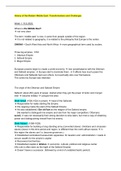History of the Modern Middle East: Transformations and Challenges
Week -2-2022
Where is the Middle East?
not very clear
The term ‘middle-east’ is new, it came from people outside of the region.
It is not related to geography, it is related to the philsophy that Europe is the center.
SWANA = South West Asia and North Africa more geographical term used by scolars.
Three big empires, 1700:
1. Ottoman Empire
2. Safavid Empire
3. Mogul Empire
European powers begin to create a world economy new powerbalance with the Ottoman
and Safavid empires. Europe start to dominate them. It affects how much power the
Ottomans and Safavids had over others, but eventually also over themselves.
The control by Europe was intended.
The origin of the Ottoman and Safavid Empire
Safavid: about 200 years of power, started when they got the power of turkic and mongol
men become military conquer the area
Shah Ismail (1500-1524 in power) head of the Safavids
Responsible for really starting the Empire.
His reigning marks the start of the Safavid Empire
He also established 12er shi’ism as the religion of the Safavid empire.
(He wanted to distinguish his empire and rule from his major competitors: Ottomans:
sunni). It was not necessarily their strong devotion to shia islam, but more a way of obtaining
power and distinguishing himself from his enemy.
Shah Abbas I (1588-1629)
Responsible for building a long standing army (converted slaves: christians and circassian
slaves) (slave in this time period and region, is different than the north african slaves in
this region the slaves can f.e. become governors.)
Established centralized bureaucratic apparatus: for taxation and administration > leads to
secure wealth for the empire’s capital.
Recovered lost territory
Established capital in Isfahan economic, cultural, political and religious center.
(His rule is often seen as the hight of the Safavid Empire)
Doesn’t leave a successor. (followed by a kind of unstable/chaotic period)
, Even though Shia Islam was already the state religion back then, it doesn’t mean we can
draw a straight line to today’s Iran.
What was daily life like back then?
Shia Islam being the state religion, doesn’t mean that ordinary people follow shia Islam’s
rules.
There were bans (tabacco, alcohol, etc) but the fact that there is a ban against
something, means it is being used in fact: binge drinking and smoking was very common
in the Safavid empire.
We see that the state religion, doesn’t necessarily show is every day life in the Empire.
Week -2-2022
Social, Economic, Political, Cultural changes in the Ottoman Empire
The Ottoman Empire saw itself as the heir of the Roman and Byzantine Empire, as Islam
saw itself as the heir of christianity and judeism.
As we saw last week, the circumvention of the middle east, was done purposely, it was
helped by the violent conquests of the America’s. this gave the European powers a lot of
power. wealth increased (and thus declined elsewhere).
The fact that european power increases, often goes hand in hand with power decreasing in
other areas.
Central theme in these next two weeks: the reform efforts of the Ottoman Empire.
(Socially, culturally, politically etc).
Keep in mind: they werent just reactions to what was going on, they were not just defences
to European superiority,it was not just for that, we also want to learn what the inhabitants
thought was imported, and what their ideas were.
There are internal and external factors (it was not just defence, lets not ignore the region
itself)
What did these powerchanges really mean?
Couple of things happen to European powers:
Centralisation of the state
Growth of finances ( census population is known tax more sufficiantly)
Growth of the state power
Increase in merchant and industrial power
What were the consequences of this shift in power for the Middle East?
1. The collapse of self-contained Empires (Safavid & Ottoman Empire)
2. Integration of world Empires into a larger capitalist world economy
3. The colonasition by European contries over the Muslim world




